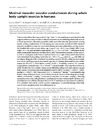Identificador persistente para citar o vincular este elemento:
https://accedacris.ulpgc.es/jspui/handle/10553/6558
| Título: | Maximal muscular vascular conductances during whole body upright exercise in humans | Autores/as: | Calbet, JAL Jensen-Urstad, Matts van Hall, Gerrit Holmberg, Hans-Christer Rosdahl, Hans Saltin, Bengt |
Clasificación UNESCO: | 241106 Fisiología del ejercicio | Palabras clave: | Cardiac output Muscle Exercise Blood flow Fatigue |
Fecha de publicación: | 2004 | Publicación seriada: | Journal of Physiology | Resumen: | That muscular blood flow may reach 2.5 l kg(-1) min(-1) in the quadriceps muscle has led to the suggestion that muscular vascular conductance must be restrained during whole body exercise to avoid hypotension. The main aim of this study was to determine the maximal arm and leg muscle vascular conductances (VC) during leg and arm exercise, to find out if the maximal muscular vasodilatory response is restrained during maximal combined arm and leg exercise. Six Swedish elite cross-country skiers, age (mean +/-s.e.m.) 24 +/- 2 years, height 180 +/- 2 cm, weight 74 +/- 2 kg, and maximal oxygen uptake (VO(2,max)) 5.1 +/- 0.1 l min(-1) participated in the study. Femoral and subclavian vein blood flows, intra-arterial blood pressure, cardiac output, as well as blood gases in the femoral and subclavian vein, right atrium and femoral artery were determined during skiing (roller skis) at approximately 76% of VO(2,max) and at VO(2,max) with different techniques: diagonal stride (combined arm and leg exercise), double poling (predominantly arm exercise) and leg skiing (predominantly leg exercise). During submaximal exercise cardiac output (26-27 l min(-1)), mean blood pressure (MAP) (approximately 87 mmHg), systemic VC, systemic oxygen delivery and pulmonary VO2(approximately 4 l min(-1)) attained similar values regardless of exercise mode. The distribution of cardiac output was modified depending on the musculature engaged in the exercise. There was a close relationship between VC and VO2 in arms (r= 0.99, P < 0.001) and legs (r= 0.98, P < 0.05). Peak arm VC (63.7 +/- 5.6 ml min(-1) mmHg(-1)) was attained during double poling, while peak leg VC was reached at maximal exercise with the diagonal technique (109.8 +/- 11.5 ml min(-1) mmHg(-1)) when arm VC was 38.8 +/- 5.7 ml min(-1) mmHg(-1). If during maximal exercise arms and legs had been vasodilated to the observed maximal levels then mean arterial pressure would have dropped at least to 75-77 mmHg in our experimental conditions. It is concluded that skeletal muscle vascular conductance is restrained during whole body exercise in the upright position to avoid hypotension. | URI: | https://accedacris.ulpgc.es/handle/10553/6558 | ISSN: | 0022-3751 | DOI: | 10.1113/jphysiol.2003.059287 | Fuente: | Journal Of Physiology-London[ISSN 0022-3751],v. 558 (1), p. 319-331 |
| Colección: | Artículos |
Vista completa
Citas SCOPUSTM
168
actualizado el 08-jun-2025
Citas de WEB OF SCIENCETM
Citations
154
actualizado el 08-jun-2025
Visitas
170
actualizado el 31-may-2025
Descargas
231
actualizado el 31-may-2025
Google ScholarTM
Verifica
Altmetric
Comparte
Exporta metadatos
Este elemento está sujeto a una licencia Licencia Creative Commons

